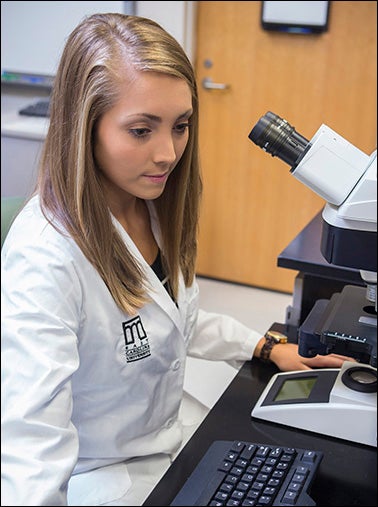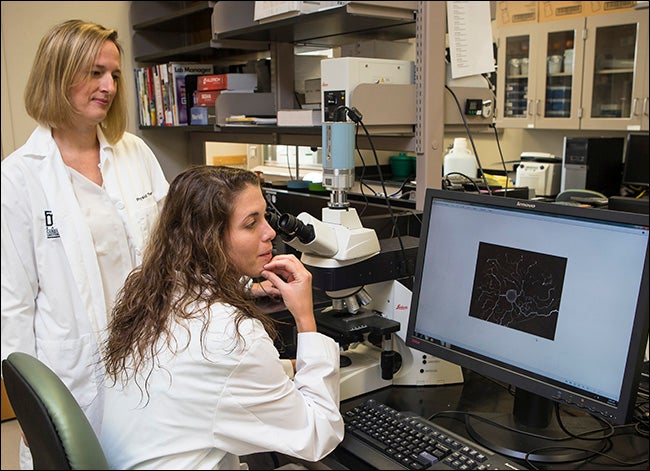NOVEL APPROACH
ECU researchers receive grant to study chronic pain
Two East Carolina University researchers have received funding for a project that could lead to better quality of life for people living with chronic pain.
Drs. Sonja Bareiss and Kori Brewer were awarded a two-year, $300,000 grant by the Craig H. Neilsen Foundation to study the development and possible treatments of the debilitating pain that commonly occurs after a spinal cord injury.

The microscope image above shows a sensory neuron from an animal that developed pain after spinal cord injury. (Photo courtesy of Sonja Bareiss)
Bareiss, an assistant professor in the College of Allied Health Sciences’ Department of Physical Therapy, practiced physical therapy for eight years before earning her doctorate in anatomy and cell biology.
“My clinical experience informs the way I ask the questions,” she said. “When I was practicing in the clinic, I didn’t feel like I had a lot of tools to treat patients with chronic pain. That motivated me to do basic science research so I could better understand what was happening with my patients.”
Subsequently, her doctoral studies focused on pain at the cellular level; specifically, how sensory neurons – which relay sensory information like pain – grow and form connections. She became especially interested in the uncontrolled growth – or “sprouting” – of sensory cells in the peripheral nerves, which are those beyond the brain and spinal cord.
“This branching off of peripheral sensory cells to form new connections in the spinal cord has been recognized in humans who’ve suffered spinal cord injury,” Bareiss said. “It’s thought to contribute to abnormal sensations, including pain.”
Brewer, an associate professor and associate chief of the Division of Research in the Brody School of Medicine’s Department of Emergency Medicine, is well versed in the basic science of pain.
The pair has collaborated since 2010, when they received seed funding from the Harriet and John Wooten Lab for Alzheimer’s and Neurodegenerative Diseases Research, which aims to jump-start Brody faculty on multidisciplinary research projects about molecular and cellular mechanisms involved in neurodegenerative diseases.

Senior exercise physiology major Blaire Conner assists in the chronic pain study.
They hope their findings will lead to an effective pharmacological treatment for the sharp, burning neuropathic pain commonly experienced by patients after spinal cord injuries. Specifically, they’re trying to determine whether reducing sensory ‘sprouting’ – with a specific drug known to stop it – will combat the pain without sacrificing motor function. Current treatments are ineffective, they said.
It could also have implications beyond pain relief.
“Chronic pain is debilitating, and it affects every facet of life,” said Bareiss. “Once these pain conditions arise, they tend to persist or worsen over time. It reduces quality of life and hinders a person’s reintegration into community and vocation.”
“What if, instead of reducing the sprouting, you were to enhance it, fostering new synaptic connections in brain cells? Could that help with Alzheimer’s? The signal may be the same,” said Bareiss.
According to the Institute of Medicine and the American Academy of Pain Medicine, chronic pain affects more than 100 million Americans – more than diabetes, heart disease and cancer combined.
One reason, Bareiss said, is people are surviving spinal cord injuries that would have proven fatal 50 years ago. Of the more than one million people who live with spinal cord injuries in the United States, about 50 percent develop neuropathic pain within the first six months of their injury, and as many as 90 percent report it at the five-year mark, she said.
Brewer called the team’s research a “novel approach to a long-standing problem” because rather than focusing on the brain or the spinal cord, they are studying the peripheral nerves that carry pain information from outlying areas of the body into the central nervous system. Understanding the cellular mechanisms involved, she said, could have applications for all types of chronic pain.
Dr. Heather Harris Wright, associate dean for research in the ECU College of Allied Health Sciences, said, “The collaboration between Dr. Bareiss and Dr. Brewer exemplifies how researchers across ECU’s Division of Health Sciences work together to address health-related issues affecting North Carolinians.
“Our college is very excited about the tremendous impact this research could have for individuals living with chronic pain.”
The Craig H. Neilsen Foundation was established in 2002 to provide funding for a broad spectrum of charities benefiting spinal cord injury research and rehabilitation.

Sonja Bareiss, standing, and ECU physical therapy doctoral student Morgan Haskins study the microscope image of a sensory neuron.